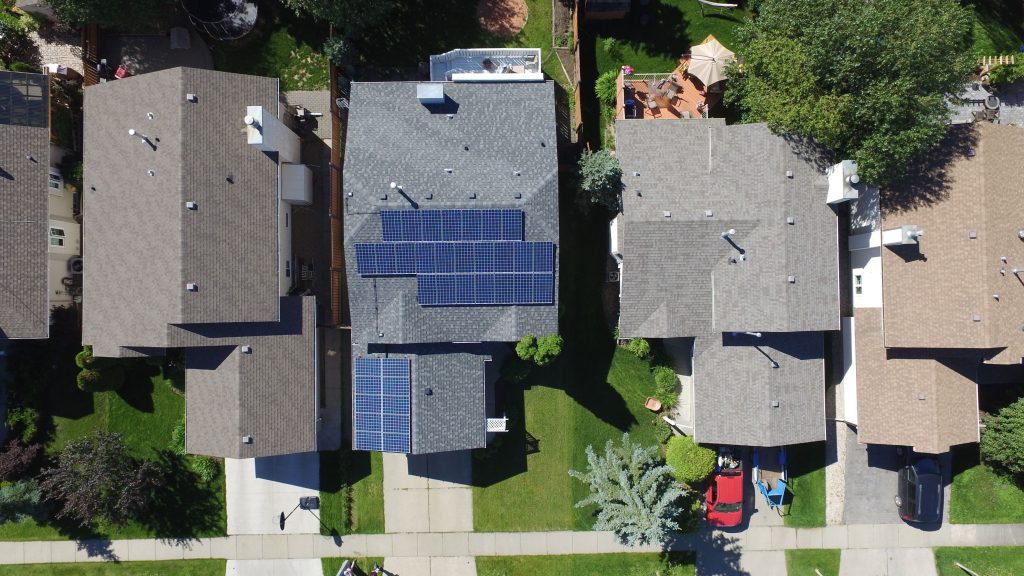By David Dodge and Scott Rollans
St. Albert’s Ron Kube had never known anyone with a solar-powered home. Then, in 2014, he read a story in the paper about a household that installed a solar array. He was surprised to learn they were his former neighbours.
“In fact, the guy was Craig Dickie—he used to live across the street from us,” Kube recalls. “And I was so excited that I called up Craig and I said, ‘Can I come over to the house and see the solar system?’ And he said, ‘Yeah, sure, come on over.’”
The moment Kube saw the system, he was hooked.
Solar power’s not the future—it’s the present
Like many Albertans, Ron was waking up to a new and exciting realization. Solar power isn’t the future—it’s the present. It’s already a practical option for producing our own clean energy. Not only does it drastically reduce your carbon footprint—in the long run, it can save you money.

Before going solar Great Canadian solar assessed Ron and Carole Kube’s electricity bills, the roof and electrical panel.
Ron did his homework, researching potential contractors at solaralberta.ca before calling up Clifton Lofthaug, owner of Edmonton’s Great Canadian Solar.
Lofthaug began by reviewing Ron and Carole’s utility bills, to see what they were consuming. Then, he calculated the size of the system needed to make their home net-zero for electricity.
Next, Lofthaug went onto the roof to evaluate the house’s solar potential. “There’s great gadgets out there that will actually tell you, automatically, how much sun you’ll get on the roof at that particular point throughout the year,” he says. Although Ron and Carole only have a small piece of south-facing roof on his garage, so he was imagining a small solar system.
“And so when they looked at our power bills and said ‘Well you’re using about 9,000 kilowatt hours a year in 2015. Are you interested in going full net-zero which means putting solar panels on the east side of the house.’ And I said ‘Yeah but let’s do that that’s a great idea.’”
Kube says they lose about 15 per cent production potential for the east-facing solar. But it also means their solar produces electricity earlier in the day.
Great Canadian Solar installed 34 solar modules on Ron and Carole’s home and garage—a nine-kilowatt system, enough to provide all of their electricity. The power runs through an inverter, which converts it to regular AC household current.
The power is used in the home and if the home doesn’t need the electricity it flows out to the grid through a newly installed power meter—one with a difference.
Energy in, energy out—no batteries required
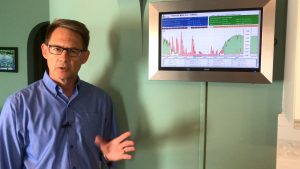
Ron Kube installed an e-gauge electricity monitoring system so he can see how much electricity his solar system is producing and where his electricity is being used.
It’s a bi-directional power meter. It measures the electricity that Ron and Carole Kube export to the grid on sunny days and the electricity they import from the grid when the sun is not shining.
The utility company pays the Kubes the same rate for electricity whether they are selling or buying. However it pays to use your solar electricity yourself, since you have to pay admin and transmission fees when you buy it back.
Tackling the myths of solar energy
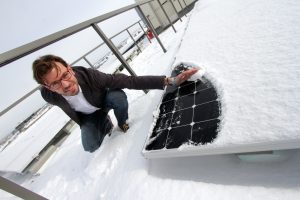
Solar systems in Edmonton, Alberta lose very little production to snow according to NAIT research and it turns out solar modules work better in the cold weather.
Where do you install the batteries? Lofthaug is asked this all the time. “You don’t need a battery,” he says. In effect, the grid serves as a kind of battery to balance out the Kube family’s electricity requirements.
Speaking of myths, how does solar work during a dark, snowy Alberta winter? “We produce over 90 per cent of our total annual electricity generation between the months of March and October,” Kube explains. “So, for that additional 10 per cent, I’m not going to go onto my roof and shovel my solar panels. Plus, normally what happens is the snow sloughs off eventually.”
Besides, according to studies at NAIT, Edmontonians lose only about five per cent to snow cover. And Alberta gets a lot of sun. Solar modules here produce an average of 50 per cent more electricity than modules in Hamburg, Germany.
Big upfront investment, but pays off in the long term
Converting your home to solar does require a significant up-front capital investment. Currently, the installed cost of solar runs about $3 per watt. A typical home in Calgary might require a 5.5-kilowatt system, with a price tag of about $16,500. In Edmonton, you’d likely require a bit more—about 6.3 kilowatts for roughly $18,900. Factor in the current provincial rebates of about 25 per cent, or $0.75/watt and solar starts to look very appealing.
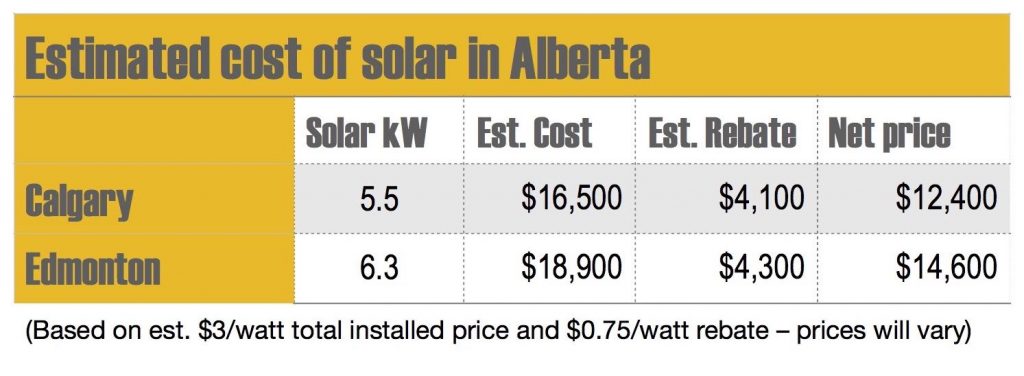
A rough guide on what it costs to go solar in Alberta. Prices and rebates will vary. Green Energy Futures Chart
According to Lofthaug, some people are willing to invest that much for the environmental benefit alone. But a solar system pays off economically as well. Your system will save you money by the end of its 25-year guaranteed lifespan—and, chances are, it will continue to chug along for decades beyond that.
You will spend the money on electricity anyway, Lofthaug figures, so why not have a solar system to show for it? “It’s just a matter of whether you’re going to pay for it [electricity] on your monthly utility bill. Or whether you invest in your own system, and then eventually have it paid off, and then get your electricity for free.”
Energy efficiency and solar are kissing cousins
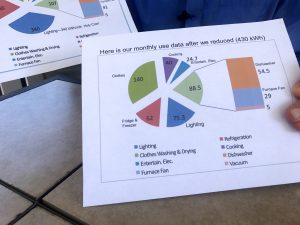
When Ron Kube decided to install solar he was shocked to learn he was using way above average amounts of electricity. By taking a few simple steps he reduced consumption by half.
When Ron caught the solar bug, he checked his own electricity bills. He was shocked to find their home was consuming 12,172 kilowatt hours of electricity per year. That’s well above the 7,200 average for Alberta homes.
Before buying their solar system Ron became an energy detective. He found it was very easy to reduce their electricity demand by changing lights, unplugging a beer fridge and making a few inexpensive changes around the home.
They reduced their energy demand to 9,000 kilowatt hours per year by the time they bought their solar system. Since then, they have further slashed energy use to an astonishing 5,300 kilowatt hours per year.
This means the Kubes now produce more solar electricity than they consume in a year.
Rather than sell that electricity back to the grid at a few cents per kilowatt hour, as he does currently, Ron hopes to consume more of his output himself by purchasing an electric vehicle. This will increase the return on his surplus power. By his own calculation, the value of charging an electric car would be 88 cents per kilowatt hour, considerably more than he’d earn exporting it to the grid.
Despite the other benefits of their new solar-power system, Ron and Carole insist that the real clincher for them was the environment—especially here in Alberta, where we have only just begun to wean our province from coal-powered electricity.
“So, for us, the biggest benefit is lowering our carbon footprint,” says Ron. “We were concerned about climate change and wanted to be able to do something.”
When you can help save the planet, become energy self-sufficient, and save a little over the long term—what’s not to love about solar power?

